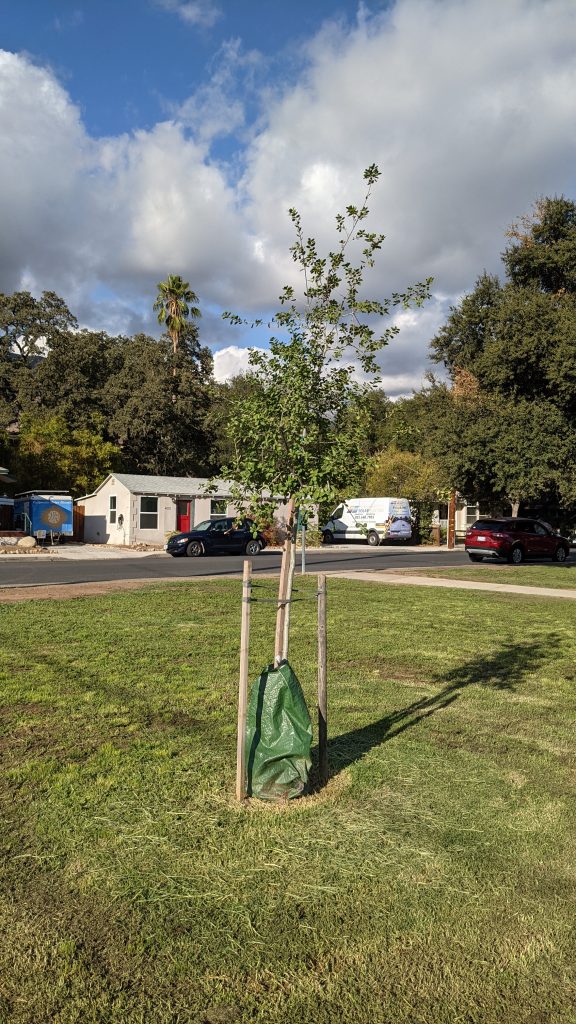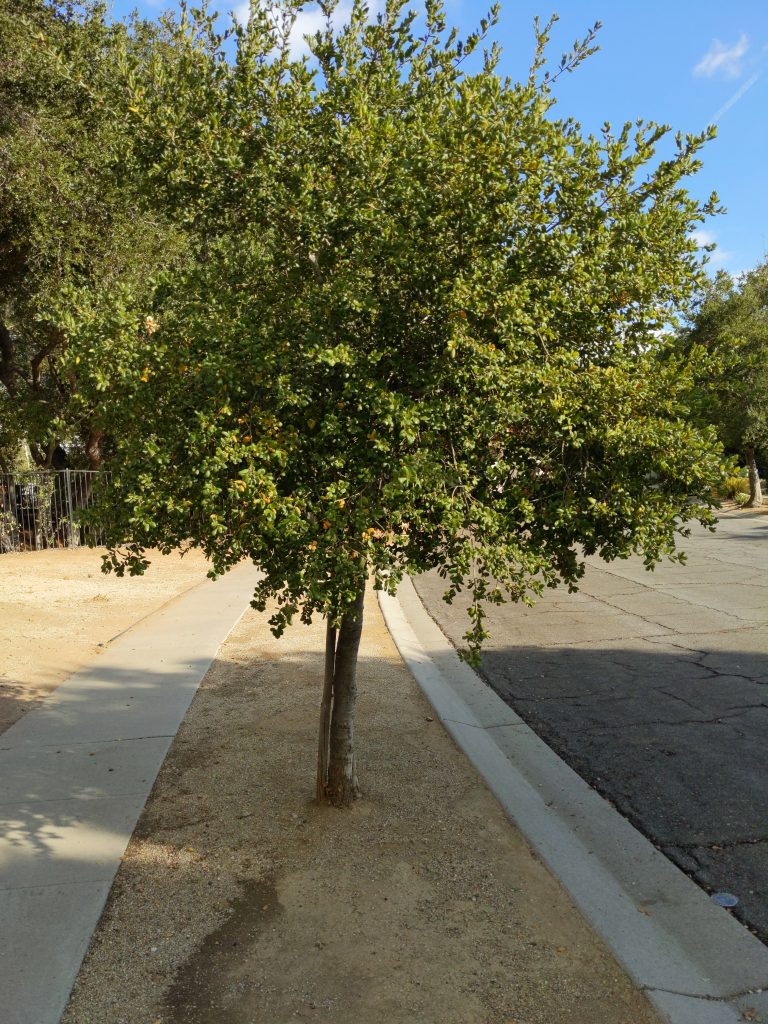As the climate warms the value of trees for cooling the environment around buildings, especially in cities, drives tree planting programs. Planting trees is just the first step in growing a tree in a sustainable landscape. Successful plantings require evaluation and guidance of the new tree’s current and future branch architecture. In almost every case, nursery grown trees will require some structural pruning so that a shade tree can develop strong and effective branch attachments that will support the canopy for the coming decades without failure. In this blog I cover maintenance of the newly planted tree including how to structurally prune young trees so that they develop strong and sustainable canopies.
As mentioned in earlier pruning blogs, trees do not require pruning. This is predicated on the assumption that trees are allowed to grow in the way they are genetically programmed to grow without damage. Unfortunately many container nurseries prune trees with a heading cut to the central leader in order to create branches that can further be pruned to make a “lollipop” canopy that mimics the form of a large tree. Consumers have become accustomed to this “in-pot” miniature version of a shade tree and nurseries are accustomed to producing them. Low branches are removed to enhance the tree lollipop shape. Nurseries often stake trees tightly to provide a way to keep them from being blown over in wind events and since all the temporary branches are removed from the low trunk they are top heavy and require rigid staking usually with a stake taped to the trunk. Tightly staked trees grow taller than unstaked trees and their trunks may lack caliper or taper (increase in trunk diameter lower on the stem). This requires that when these trees are planted out that they continue to be staked, otherwise they would fall over. This creates another burden in getting the newly planted landscape tree to survive—helping trees stand on their own.


Nursery pruning creates two kinds of branch faults that if left in the tree canopy will lead to failure later. These result from heading the main leader of the young tree. When buds grow from the pruned tree, they often produce too many branches from the same place or two branches or new leaders that are the same size. We call these faults: too many branches from one point and codominant stems respectively. If the nursery tree retains these branches and they are allowed to mature in the landscape tree, one or more branches may break loose. Almost all structural pruning seeks to correct these faults at some point in the life of a nursery-grown landscape tree. The approaches are different depending on how long the branch fault is left in the tree after planting. Branch faults of newly planted trees are best corrected in the first year–they are easy to correct in the first few years and problematic after that. This is because when poorly attached branches grow well and attain greater size over time, they will pose a problem upon removal as pruning will leave behind a substantial wound which provides an entry point for wood decay. Structural pruning is best done in the nursery or if in the landscape, in the first year after planting.

There are several goals of early pruning (1-3 years post planting):
-Retain temporary branches on the stem to assist trunk growth (but keep them pruned)
-Remove competing leaders (remove a co-dominant stem)
– Thin clusters of branches (fix the all branches from one point fault)
-Leave the first permanent branch unpruned
-Subordinate all other branches to “temporary” status by heading them back
– Leave unpruned branches along the stem that will take a permanent place in the crown of the tree.
-Leave enough space between permanent branches to support their sustained growth over the life of a tree
-Permanent branches should be spaced vertically and helically around the main or central leader
Most trees will do all of this without any pruning if they are unpruned from the seedling stage. They will shade out their temporary branches and permanent large branches will form strong attachments and uniform spacings. Heading cuts on young trees destroy their form and this should be avoided. In the next blog I will cover pruning young to mature trees.
I would caution readers not to prune new transplants until roots are established. See Myth #4 here: https://www.nacaa.com/journal/index.php?jid=885
I would like to suggest that planting a tree is definitely not the first step in the process of actually GROWING a tree well into maturity – its, not ours. The first step must be assessing the site in which you are asking a tree to exist. What can that site provide? How much soil will the tree’s roots be able to explore without green or grey competition issues? What is the pH of the soil as well as its structure – a good barometer is to look at what’s already growing well at the site. How much sun will the tree receive on a daily basis and are there any re-radiation issues that the crown will have to contend with if the trees is planted too close to a building? In addition to planning a site that can accommodate the tree that will exist there, knowledgeable tree selection is the critical next step. Nursery practices can create problems that cannot be corrected and it is important to make sure that the tree, before it is dug, has its trunk flare at grade. Otherwise, the tree will come with even less roots than the normal 5%. It’s also important that if it’s a container grown tree, the roots are not girdling throughout the ball. Last, the tree should be true to its species’ architecture without any heading cuts or other unnecessary re-arrangements of its crown. One should be able to see good annual shoot extension which is an excellent indicator of vitality. Once we have these 2 critical steps accomplished and these as well as other pertinent questions answered, planting and establishment step in with all their important criteria. Growing a tree well into maturity is front-loaded. If we address all the critical requirements leading up planting and establishment, the result will be a healthy tree with greatly reduced maintenance needs.
Naomi, I covered much of this just a few weeks ago. Jim’s post is really focused on pruning. https://gardenprofessors.com/save-the-planet-learn-how-to-plant-a-tree/
Thanks, Linda. I still would have rephrased the opening paragraph and the sentence “Planting trees is just the first step in growing a tree in a sustainable landscape.” Regardless of previous articles, we should always state these different actions correctly so that we remind that after planning and designing a tree-friendly site and selecting an excellent representation of the species, we want tot plant, the next step is planting that tree.
Invariably, it is those 2 critically important initial steps that are forgotten and, as a result, we have trees that decline and die much too early.
Nursery pruning pre-purchase may explain why my columnar beech lost it’s shape and developed into an atypical beech –neither natural or columnar!
There are certain nursery pruning practices, such as heading back cuts, that are contrary to species architecture and to a tree’s structural integrity. In selecting a tree at a nursery, it’s really important to have a good understanding of that species’ architecture and have that picture in mind when selecting the tree. Another critical element is that the trunk flare is visible and not buried which often happens as a result of nursery practices with field grown trees. It’s important to ask the nursery to locate the trunk flare before digging the tree so that you end up with as much of the existing root system as possible in the resulting root ball.
These are all valid points that have been discussed in earlier blog posts. I invite readers to use the search bar in the left hand menu to find these posts and the pictures that illustrate them.
I work in a retail nursery and would like to mention that we purchase trees and shrubs from vendors that are already at the #3-#7 pot size (and rarely up to #15 because we are not a large establishment). I understand staking as a precaution for loading (more precisely crammed and jammed) into the semi-trucks but I have put into practice the removal of all stakes once the plants are place in our nursery. The tape has almost always cut into the bark and often the stakes break off inside the pot when we try to pull them out, been in there so long they’ve started to decompose. The exception are weeping Japanese Maples that we re-tie with loose garden twine. We even got “perfectly shaped” boxwoods that were actually several branches tightly tied to a central stake, twigs, leaves and all to appear pointy. When I took those stakes out they no longer held their shape – even though they are now in better health, they no longer have that $$$ shape.
It’s not just the nurseries that need to be educated (and to educate their customers) but those who supply the nurseries, who are growing massive amounts of “products” without considering that plants have lives to live, too.
I was reeferring to production nurseries in my blog. However, retail nurseries are also culpable because they often offer to prune a new fruit tree for gardeners purchasing bare root stock. Of course not ALL nurseries behave this way but customers should be on their guard and look for trees with a strong central leader and terminal bud which they can preserve after planting.
This is one of the difficulties with retail nurseries as opposed to growers. One has much more control over plant selection when the purchase is made directly from a local grower of these trees and shrubs. Retail nurseries buy from mass growers. One never knows the provenance and the material is often not produced to any acceptable standard. Local growing nurseries are usually open to retail as well as wholesale buyers. It’s also critical to thoroughly investigate all the requirements and attributes before selecting. The end result should be “the right tree in the right place”.
Thanks for your content. I like it. The other day my wife mentioned that she was looking to improve the landscaping of our home. I found it interesting when i looked for some landscaping tips and reached out your blog. After reading this post, I have learned much pruning tips and some of those things are what I would look for first. I have a few large old apple trees and newly planted trees in our back yard, and i would carry out landscaping work especially the pruning task for those ones. I have also used a good tree removal ri but it seemed i got to DIY for saving more money now
Thank you for your incredibly informative content. After reading your article, I learned a lot about pruning and how to care for a newly planted tree.
Thanks Jim, awesome article to help people with pruning tips!